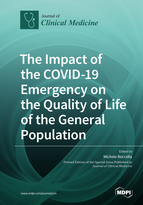The Impact of the COVID-19 Emergency on the Quality of Life of the General Population
A special issue of Journal of Clinical Medicine (ISSN 2077-0383). This special issue belongs to the section "Mental Health".
Deadline for manuscript submissions: closed (20 December 2021) | Viewed by 271469
Special Issue Editor
Interests: neurodevelopmental disorders; encephalopathies; epilepsies; neuromuscular diseases; sleep disorders; rare genetic syndromes; neuropsychological disorders
Special Issues, Collections and Topics in MDPI journals
Special Issue Information
Dear Colleagues,
COVID-19 is a pandemic that has forced many states to declare restrictive measures in order to prevent its wider spread. These measures are necessary to protect the health of adults, children, and people with disabilities.
Long quarantine periods could cause an increase in anxiety crises, fear of contagion, and post-traumatic stress disorder (frustration, boredom, isolation, fear, insomnia, difficulty concentrating).
Post-traumatic stress disorder (PTSD) is a condition that can develop in subjects who have been or have witnessed a traumatic, catastrophic, or violent event, or who have become aware of a traumatic experience that happened to a loved one.
In fact, from current cases, it emerges that the prevalence of PTSD varies from 1% to 9% in the general population and can reach 50%–60% in subgroups of subjects exposed to traumas considered particularly serious. PTSD develops as a consequence of one or more physical or psychological traumatic events, such as exposure to natural disasters such as earthquakes, fires, floods, hurricanes, tsunamis; wars, torture, death threats; road accidents, robbery, air accidents; diseases with unfavorable prognoses; complicated or traumatic mourning; physical and sexual abuse and abuse during childhood; victimization and discrimination based on gender, sexual orientation, gender identity. It can also develop following changes in lifestyle habits caused by the COVID-19 epidemic.
We welcome manuscripts on the impact of the COVID-19 emergency on the quality of life of the general population, children, and people with disabilities.
We will be happy to review your contributions to our Special Issue in the Journal Clinical Medicine.
Dr. Michele Roccella
Guest Editor
Manuscript Submission Information
Manuscripts should be submitted online at www.mdpi.com by registering and logging in to this website. Once you are registered, click here to go to the submission form. Manuscripts can be submitted until the deadline. All submissions that pass pre-check are peer-reviewed. Accepted papers will be published continuously in the journal (as soon as accepted) and will be listed together on the special issue website. Research articles, review articles as well as short communications are invited. For planned papers, a title and short abstract (about 100 words) can be sent to the Editorial Office for announcement on this website.
Submitted manuscripts should not have been published previously, nor be under consideration for publication elsewhere (except conference proceedings papers). All manuscripts are thoroughly refereed through a single-blind peer-review process. A guide for authors and other relevant information for submission of manuscripts is available on the Instructions for Authors page. Journal of Clinical Medicine is an international peer-reviewed open access semimonthly journal published by MDPI.
Please visit the Instructions for Authors page before submitting a manuscript. The Article Processing Charge (APC) for publication in this open access journal is 2600 CHF (Swiss Francs). Submitted papers should be well formatted and use good English. Authors may use MDPI's English editing service prior to publication or during author revisions.
Keywords
- post-traumatic stress disorder (PTSD);
- COVID-19 emergency;
- disabilities
- quality of life
- stress disorder







